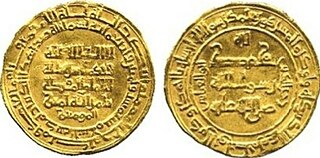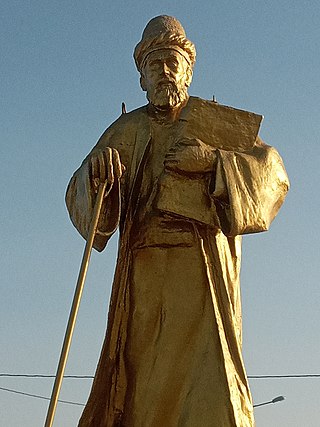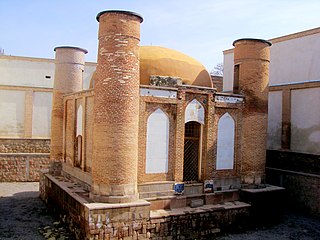Related Research Articles

Jalāl al-Dawla Mu'izz al-Dunyā Wa'l-Din Abu'l-Fatḥ ibn Alp Arslān, better known by his regnal name of Malik-Shah I, was the third sultan of the Great Seljuk Empire from 1072 to 1092, under whom the sultanate reached its zenith of power and influence.

Abu Shuja Ghiyath al-Dunya wa'l-Din Muhammad ibn Malik-Shah, better known as Muhammad I Tapar, was the sultan of the Seljuk Empire from 1105 to 1118. He was a son of Malik-Shah I and Taj al-Din Khatun Safariya. In Turkish, Tapar means "he who obtains, finds".

Abū'l-Qasim ʿAbd Allāh ibn Muhammad ibn al-Qa'im better known by his regnal name Al-Muqtadi was the Abbasid caliph in Baghdad from 1075 to 1094. He succeeded his grandfather caliph al-Qa'im in 1075 as the twenty-seventh Abbasid caliph.

Al-Tha'alibi (961–1038), was a writer famous for his anthologies and collections of epigrams. As a writer of prose and verse in his own right, distinction between his and the work of others is sometimes lacking, as was the practice of writers of the time.

Rukn al-Din Abu'l-Muzaffar Berkyaruq ibn Malikshah, better known as Berkyaruq (برکیارق), was the fifth sultan of the Seljuk Empire from 1094 to 1105.
Shabankara was an Iranian tribe. They claimed descent from the mythical Iranian king Manuchehr who had been deported to eastern Fars from Isfahan by the Buyid Shahanshah 'Adud al-Dawla. The dynasty's capital was Ij (Ig) and was divided in six districts: Zarkān, Iṣṭabānān, Burk-Tārum-K̲h̲ayra, Nayriz, Kurm-Rūnīz-Lār, and Darabjird. The tribe had the following subdivisions: Ismāʿīlī, the Rāmānī, the Karzuwī, the Masʿūdī and the S̲h̲akānī who were all herders and warriors.
The Seljuk Empire, or the GreatSeljuk Empire, was a high medieval, culturally Turco-Persian, Sunni Muslim empire, founded and ruled by the Qïnïq branch of Oghuz Turks. It spanned a total area of 3.9 million square kilometres from Anatolia and the Levant in the west to the Hindu Kush in the east, and from Central Asia in the north to the Persian Gulf in the south.
Qudāma ibn Jaʿfar al-Kātib al-Baghdādī, was a Syriac scholar and administrator for the Abbasid Caliphate.

The Salghurids, also known as the Atabegs of Fars, were a Persianate dynasty of Salur Turkmen origin that ruled Fars, first as vassals of the Seljuqs then for the Khwarazm Shahs in the 13th century.

Amid al-Mulk Abu Nasr al-Kunduri, commonly known as al-Kunduri, was a Persian bureaucrat, who served as the vizier of the first Seljuk Sultan Tughril and his nephew Alp Arslan.
Abu'l-Qasim Darguzini, commonly known as Darguzini was a Persian bureaucrat and one of the leading figures of the Seljuk Empire in the early 12th century.
Qiwam al-Din al-Fath ibn Ali ibn Muhammad al-Bundari al-Isfahani, commonly known as Bundari was an Iranian writer, who is notable for translating the Persian epic poem Shahnameh into Arabic.

The following is a timeline of the history of the city of Isfahan, Iran.
By the late 11th century, the Shi'a sub-sect of Ismailism had found many adherents in Persia, although the region was occupied by the Sunni Seljuk Empire. The hostile tendencies of the Abbasid–Seljuk order triggered a revolt by Ismailis in Persia under Hassan-i Sabbah.
Abū Naṣr Alī ibn Hibat Allāh ibn Ja'far ibn Allakān ibn Muḥammad ibn Dulaf ibn Abī Dulaf al-Qāsim ibn ‘Īsā al-Ijlī, surnamed Sa’d al-Muluk and known as Ibn Mākūlā was a highly regarded Arab muḥaddith and historian who authored several works. His magnum opus was his biographical-genealogical history on etymology and orthography of Islamic names, Al-Ikmāl.

Battle of Kerj Abu Dulaf was fought in 1073 between the Seljuk Army of Malik-Shah I and Kerman Seljuk army of Qavurt and his son, Sultan-shah. It took place approximately near Kerj Abu Dulaf, the present-day between Hamadan and Arak, and was a decisive Malik-Shah I victory.
Mu'ayyid al-Mulk was a Persian bureaucrat, who served as the vizier of the Seljuk sultan Berkyaruq from 1094 to 1095, and later vizier of the Seljuk prince and contender Muhammad I Tapar from 1099 to 1101. He was the most energetic and gifted of the sons of Nizam al-Mulk, with whom he neared in capability.
The Khujandi family was a Shafi'i family of religious scholars based in the city of Isfahan in central Iran, who played a leading role in Isfahani politics during the Seljuk era and up until the Mongol invasion. Their name refers to their hometown of Khujand in Transoxiana, which was then under Qarakhanid rule. The founder of the family was Abu Bakr Muhammad ibn Thabit al-Khujandi, who was appointed the head of a Shafi'i school in Isfahan by the Persian vizier of the Seljuks, Nizam al-Mulk. Owing to their origins, the Khujandis manifested a Khurasanian identity, but by the 12th-century they had adopted the western Iranian identity of the locals.

Abu Mansur Wahsudan was the penultimate Rawadid amir (ruler) of Azarbaijan from 1025 to 1058/59. He is considered the most prominent ruler of his dynasty. With the assistance of his Kurdish neighbours, he initially contained the attacks of migrating Turkmen tribes, but was eventually forced to acknowledge the authority of the Seljuk ruler Tughril in 1054. He was succeeded by his son Abu Nasr Mamlan II.
Akhbār al-dawla al-saljūqiyya is a chronicle which deals with the history of the Seljuks and the Eldiguzids. Probably written in c. 1262, it is the abridged and extant version of the original and non-extant Zubdat al-tawārīkh, which was written in Arabic by the 12th-century Iranian author Sadr al-Din Husayni.
References
- 1 2 Bulliet 1986, p. 1157.
- 1 2 3 Durand-Guédy 2008, p. 70.
- ↑ Durand-Guédy 2008, p. 69.